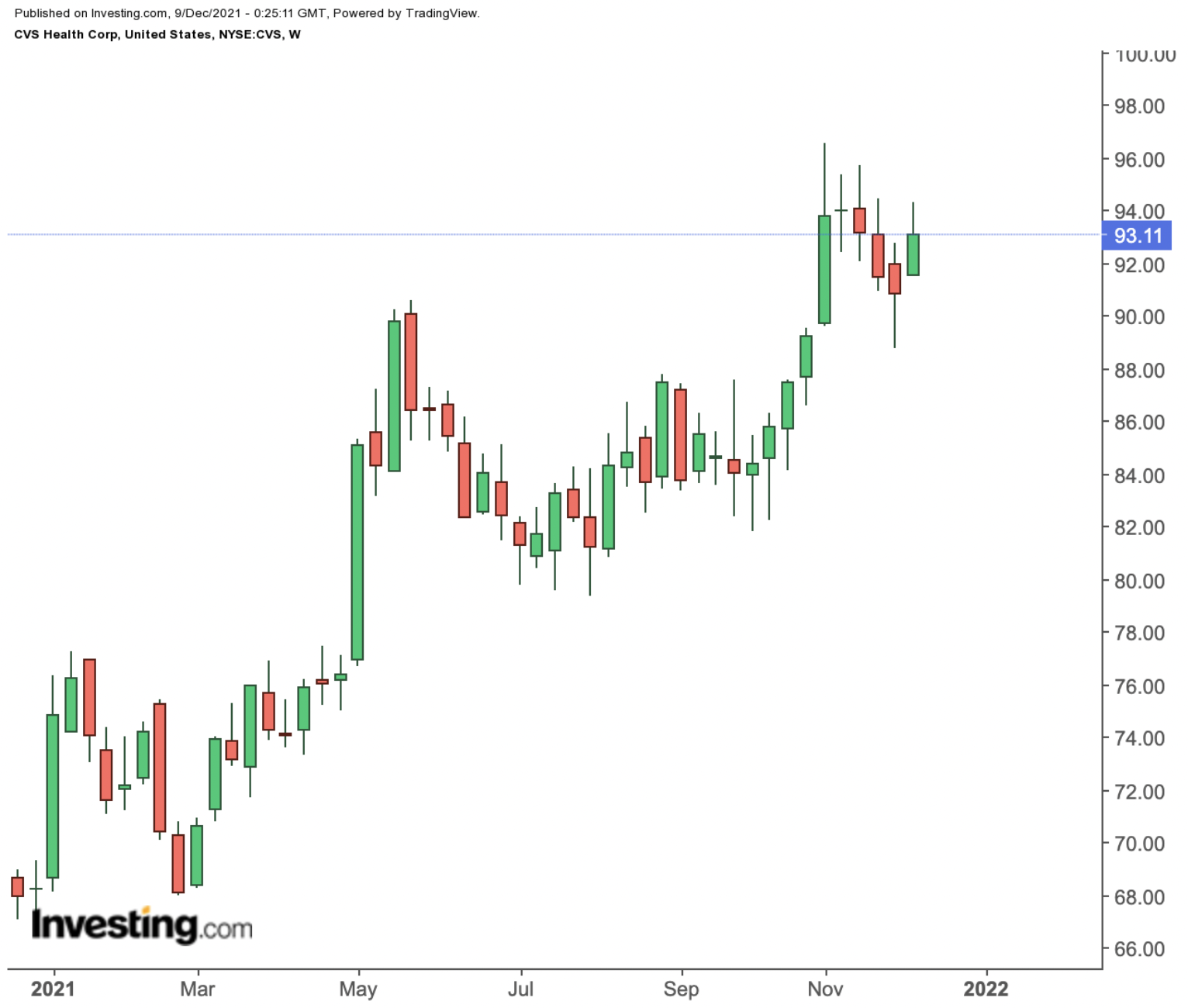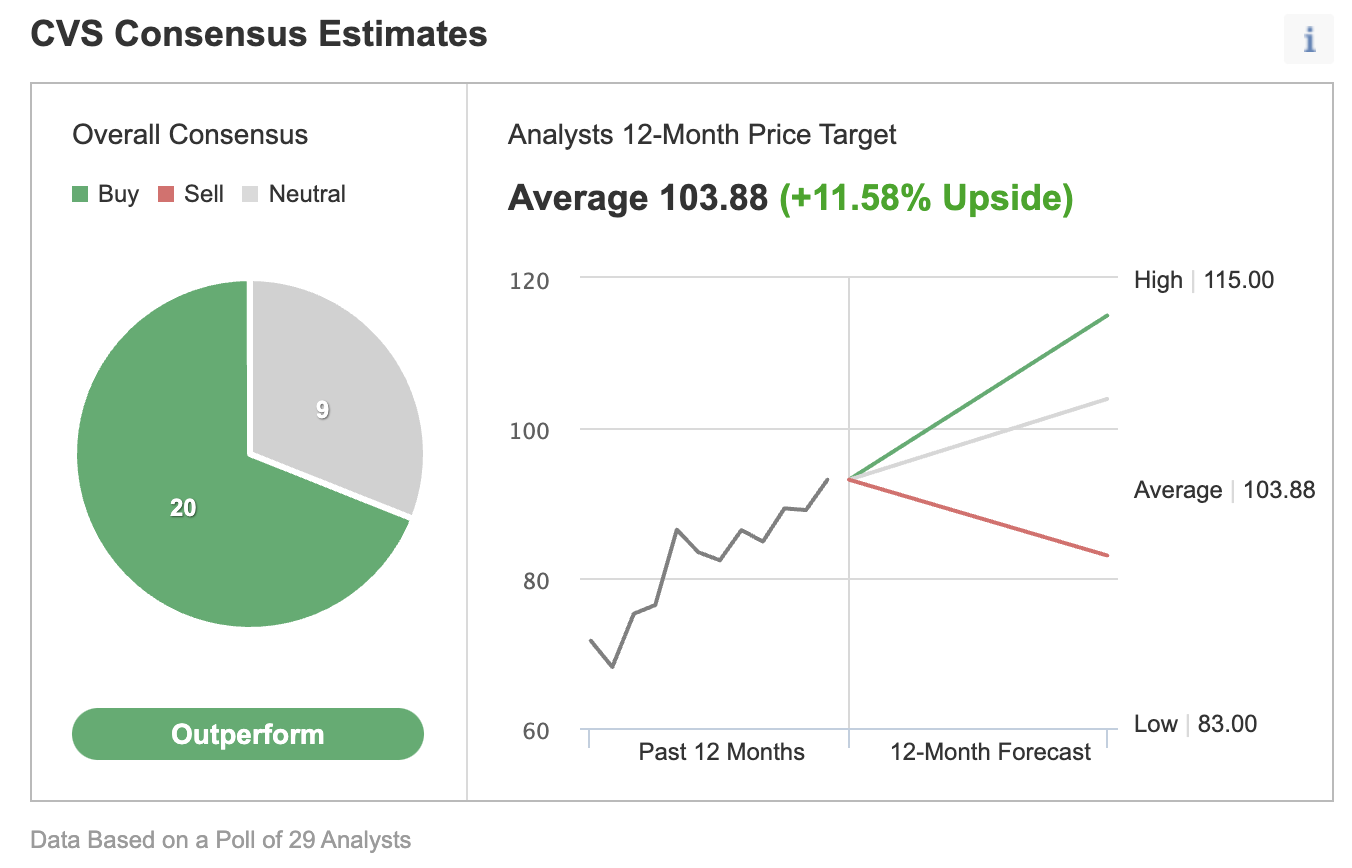- Retail pharma giant CVS stock is up around 35.6% in 2021.
- The company is holding an investor meeting on Dec. 9, the first such event in more than two years
- Long-term investors could consider buying the dips in CVS shares, especially if the price declines toward $88.
Investors in the diversified healthcare group CVS Health (NYSE:CVS) have seen robust returns in 2021. Year-to-date, CVS shares are up more than 35.6%. In comparison, the Dow Jones U.S. Drug Retailers Index has returned 13.2%.

On Nov. 3, with the release of robust Q3 2021 financial figures, CVS shares initially went over $96.50 and hit a multi-year high. But since that peak, shares have come under pressure, losing 3.6%. Now, they are trading at $93.10 as of Wednesday's close.
The recent decline is in part due to the announcement that management would close around 900 stores (representing about 10% of the company’s retail footprint) over the next three years. The stock’s 52-week range has been $67.06 - $96.57, and the market capitalization stands at $123 billion.
CVS Health’s revenue in Q3 was $73.8 billion, compared with $67.1 billion a year ago. Adjusted diluted earnings per share (EPS) was $1.97 vs. $1.66 in Q3 2020 period.
After the release of financials, CVS raised its 2021 full-year adjusted EPS guidance from $7.90 to $8.00. The company is holding an investor day webcast on Dec. 9 after a more than two year hiatus on such events. The company is expected to share 2022 guidance and long-term targets. Meanwhile, the current analyst estimate for 2022 adjusted EPS of $8.20 is in line with the company's initial guidance.
During the November earnings conference call, CEO Karen Lynch commented:
“During the third quarter, we delivered revenue growth of 10%. This double-digit growth was led by membership gains in both healthcare benefits and pharmacy services as well as higher volume in retail. We grew adjusted operating income by 12.5%.”
What To Expect From CVS Health Stock
Among 29 analysts polled via Investing.com, CVS stock has an “outperform" rating.
Analysts also have a 12-month median price target of $103.88, implying an increase of about 12% from current levels. The 12-month price range currently stands between $83.00 and $115.00.

Chart: Investing.com
Similarly, according to a number of valuation models, like those that might consider dividends, P/E multiples or the 10-year Discounted Cash Flow (DCF) growth exit method, the average fair value for CVS stock stands at $122.21.
Moreover, we can look at the company’s financial health determined by ranking it on more than 100 factors against peers in the healthcare sector. In terms of growth and profit health, CVS Health scores 4 out of 5 (top score), and, thus, has great performance.
Trailing P/E, P/B and P/S ratios for CVS stock are 16.1x, 1.6x and 0.4x, respectively. By comparison, those metrics for peers stand at 12.9x, 3.1x and 0.7x.
Readers who watch technical charts might be interested to know that several of CVS stock’s long-term indicators are cautioning investors and providing overbought signals.
Our first expectation is for CVS Health stock to continue to slide down toward $90, or even $88, after which it should find support. Then, it will likely trade sideways between $89 and $91 and establish a new base. Afterward, a new bullish move is likely to start.
3 Possible Trades On CVS Health Stock
1. Buy CVS Shares At Current Levels
Investors who are not concerned with daily moves in price and who believe in the long-term potential of the company could consider investing in CVS Health stock now.
On Dec. 8, CVS shares closed at $93.10. Buy-and-hold investors should expect to keep this long position for several months while the stock makes an attempt toward almost $104, a level which matches analysts’ estimates. Such an up-move would mean a return of over 12% from the current level.
2. Buy An ETF With CVS As A Holding
Readers who do not want to commit capital to CVS Health stock but would still like to have exposure to the shares could consider researching a fund that holds the company as a holding.
Examples of such ETFs include:
- iShares U.S. Healthcare Providers ETF (NYSE:IHF): The fund is up 15.5% YTD, and CVS stock’s weighting is 13.53%;
- First Trust S-Network Global E-Commerce ETF (NASDAQ:FTXD): The fund is up 28.4% YTD, and CVS stock’s weighting is 5.90%;
- Invesco S&P 500® Enhanced Value ETF (NYSE:SPVU): The fund is up 28.5% YTD, and CVS stock’s weighting is 5.09%;
- QRAFT AI-Enhanced U.S. Next Value ETF (NYSE:NVQ): The fund is up 20.8%YTD, and CVS stock’s weighting is 3.87%.
3. Bear Put Spread
A number of investors could be concerned that CVS Health shares might fall further. If they are experienced with options trading strategies, they could follow a bear put spread strategy.
However, as we regularly highlight, many option strategies are not suitable for most retail investors. Therefore, the following discussion is offered for educational purposes as opposed to an actual strategy to be followed by the average retail investor.
Note:This is a risky trade that's not suitable for beginner options investors.
In a bear put spread, a trader has a long put with a higher strike price as well as a short put with a lower strike price. Both legs of the trade have the same underlying stock (i.e., CVS Health) and the same expiration date.
The trader wants CVS stock to decline in price. However, in a bear put spread, both the potential profit and potential loss levels are limited. Such a bear put spread is established for a net cost (or net debit), which represents the maximum loss.
As we write, the CVS stock is $93.10.
For the first leg of this strategy, the trader might buy an at-the-money (ATM) or slightly out-of-the-money (OTM) put option, like the CVS Jan. 21, 2022, 92.5-strike put option. This option is currently offered at $3.15. It would cost the trader $315 to own this call option that expires in less than two months.
For the second leg of this strategy, the trader sells an OTM put, like the CVS Jan. 21, 2022, 90-strike call option. This option’s current premium is $2.05. The option seller would receive $205, excluding trading commissions.
In our example, the maximum risk will be equal to the cost of the spread plus commissions. Here, the net cost of the spread is $1.10 ($3.15 – $2.05 = $1.10).
As each option contract represents 100 shares of the underlying stock, i.e. CVS, we’d need to multiply $1.10 by 100, which gives us $110 as the maximum risk.
The trader could easily lose this amount if the position is held to expiry and both legs expire worthless, i.e., if the CVS stock price at expiration is above the strike price of the long put (or $92.50 in our example).
Let’s also look at the maximum profit potential for this trade. In a bear put spread, potential profit is limited to the difference between the two strike prices minus the net cost of the spread plus commissions.
So in our example, the difference between the strike prices is $2.50 ($92.50 – $90.00 = $2.50). And as we’ve seen above, the net cost of the spread is $2.50
The maximum profit, therefore, is $1.40 ($2.50 – $1.10 = $1.40) per share less commissions. When we multiply $1.40 by 100 shares, the maximum profit for this option strategy comes to $140.
The trader will realize this maximum profit if CVS Health's stock price is at or below the strike price of the short put (lower strike) at expiration (or $90.00 in our example).
Investors who have traded options before are likely to know that short put positions are typically assigned at expiration if the stock price is below the strike price (i.e., $90.00 here).
However, there is also the possibility of early assignment. Therefore, the position would need monitoring up until expiration.
Finally, we should also calculate the break-even point for this trade. At that break-even price, the trade will not gain or lose any money.
At expiration, the strike price of the long put (i.e., $92.50 in our example) minus the net premium paid (i.e., $1.10 here) would give us the break-even CVS Health price.
In our example: $92.50 − $1.10 = $91.40 (minus commissions)
Bottom Line On CVS Health Shares
We regard CVS stock to be a solid long-term choice for most retail portfolios that want exposure to the diversified healthcare segment. However, shares could come under pressure in the weeks ahead.
